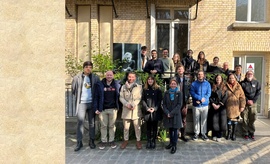Abstract 4813: EMT inducers catalyze malignant transformation of mammary epithelial cells and drive tumorigenesis towards claudin-low tumors
Abstract
The malignant transformation of human epithelial cells is generally described as a multistep process resulting from the accumulation of five to seven rate-limiting changes. Here, we challenge this dogma and demonstrate that this number is radically reduced when cells undergo an epithelial-mesenchymal transition (EMT). EMT is an embryonic transdifferentiation process that consists of the conversion of polarized epithelial cells into motile mesenchymal ones. EMT-inducing transcription factors, including Twist and Zeb proteins, are aberrantly expressed in multiple tumor types and are known to favor the metastatic dissemination process. We demonstrate that, beyond their prometastatic potential, EMT inducers also act as potent drivers of tumorigenesis. We indeed show that the Twist1 EMT-inducing transcription factor promotes breast and skin cancer development in vivo in cooperation with the K-RasG12D oncoprotein. Importantly, in the model of breast tumorigenesis, transgene expression in differentiated mammary epithelial cells leads to the development of undifferentiated tumors exhibiting all the characteristic features of the claudin-low subtype. These observations challenge the concept that this tumor subtype specifically arises from transformation of an early epithelial precursor with inherent stemness properties and metaplastic features. Consistently, oncogenic cooperation assays performed in human mammary epithelial cells with Twist or Zeb EMT-inducers in combination with H-RasG12V generate transformed cell lines displaying all characteristics of claudin-low tumors including mesenchymal features, undifferentiated traits, and stem-cell-like properties. EMT might thus drive the development of claudin-low tumors by exhibiting a dual role in cell transformation and dedifferentiation. In other terms, the claudin-low tumor subtype of breast cancers might thus constitute a first example of human adult malignancies driven by aberrant reactivation of an embryonic transdifferentiation program.
Citation Format: {Authors}. {Abstract title} [abstract]. In: Proceedings of the 103rd Annual Meeting of the American Association for Cancer Research; 2012 Mar 31-Apr 4; Chicago, IL. Philadelphia (PA): AACR; Cancer Res 2012;72(8 Suppl):Abstract nr 4813. doi:1538-7445.AM2012-4813






